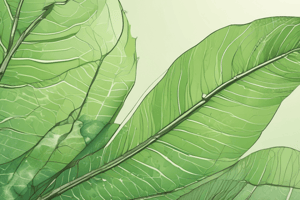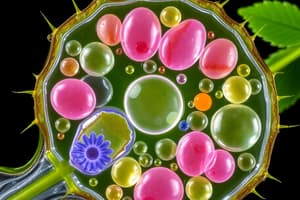Podcast
Questions and Answers
Osmosis is a type of diffusion specifically involving the movement of water.
Osmosis is a type of diffusion specifically involving the movement of water.
True (A)
Capillary action helps to move carbon dioxide from the roots up to the leaves.
Capillary action helps to move carbon dioxide from the roots up to the leaves.
False (B)
Transpiration is the process by which plants lose water through evaporation.
Transpiration is the process by which plants lose water through evaporation.
True (A)
Chlorophyll is responsible for making leaves colorful by absorbing all light except green.
Chlorophyll is responsible for making leaves colorful by absorbing all light except green.
Active transport in plants requires energy to move nutrients into cells.
Active transport in plants requires energy to move nutrients into cells.
Photosynthesis occurs in the dark, primarily at night.
Photosynthesis occurs in the dark, primarily at night.
The word equation for cellular respiration is: Sugar + Oxygen Æ Carbon Dioxide + Water + Energy.
The word equation for cellular respiration is: Sugar + Oxygen Æ Carbon Dioxide + Water + Energy.
Guard cells control the opening and closing of the stomata by absorbing or releasing carbon dioxide.
Guard cells control the opening and closing of the stomata by absorbing or releasing carbon dioxide.
Flashcards
Seed plants
Seed plants
The largest group of plants, having specific structures with unique functions.
Osmosis
Osmosis
The diffusion of water through a differentially permeable membrane.
Differentially permeable membrane
Differentially permeable membrane
A barrier allowing only certain substances to pass through.
Capillary action
Capillary action
Signup and view all the flashcards
Transpiration
Transpiration
Signup and view all the flashcards
Photosynthesis
Photosynthesis
Signup and view all the flashcards
Cellular respiration
Cellular respiration
Signup and view all the flashcards
Guard cells
Guard cells
Signup and view all the flashcards
Study Notes
1.0 Understanding Plant Structures and Processes
- Plant structures and processes help us understand plant needs
1.1 Seed Plants
- Seed plants are the largest group of plant types
- Each seed plant part has specific functions
1.2 Plant Processes
Moving Water Up From the Roots
- Water moves from the roots to other parts of the plant through multiple processes
- Osmosis: a type of diffusion where only some particles pass through a barrier (differentially permeable membrane); water diffuses
- Capillary action: water particles attract each other and tube sides; pushing and pulling diffuses water through the xylem in the stem
- Active Transport: moves water and nutrients across a concentration gradient, requiring energy
Making Food
- Chlorophyll makes leaves green
- Chlorophyll traps sunlight's energy into chemical energy
- Plants use carbon dioxide and water through photosynthesis to make sugar and release oxygen
- Respiration releases oxygen at night when photosynthesis isn't occurring
Using Food
- Cellular Respiration: a gas exchange process where plants release carbon dioxide and absorb oxygen
- Water enters and leaves the cells through guard cells which open and close stomata (pores)
- Cellular respiration equation: Sugar + Oxygen → Carbon Dioxide + Water + Energy
Studying That Suits You
Use AI to generate personalized quizzes and flashcards to suit your learning preferences.




